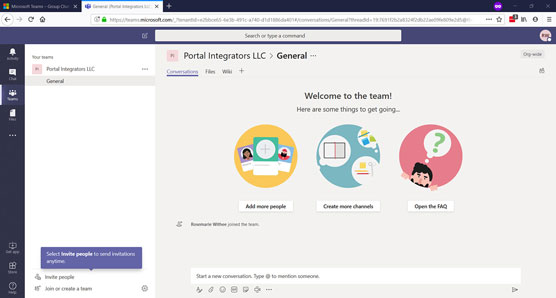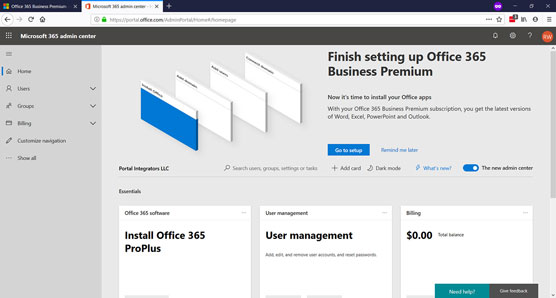The more robust version of Teams available through a subscription to Microsoft 365 or Office 365 provides all of those features as well as a whole host of others including 1TB of storage per organization; Exchange email hosting; access to OneDrive, SharePoint, and other Office 365 services; enhanced security features; and 24/7 phone and web support among other administrative tools. Explore the details about the differences between the various Teams versions (see the following figure).
 The differences between the free version and paid version of Microsoft Teams.
The differences between the free version and paid version of Microsoft Teams.Microsoft 365 and Office 365 are similar umbrella marketing terms for a bundle of subscription services. Office 365 is focused on Office products, while Microsoft 365 includes additional subscriptions such as Windows and Microsoft’s cloud-based mobile device management service called Intune. The Office 365 subscription includes services like SharePoint, Word, Excel, Teams, and many others. The Microsoft 365 subscription is a bigger umbrella that includes these Office 365 products and other products like Windows, Intune, and more.
Download Microsoft Teams for free
You can sign up for Teams for free without buying the Microsoft 365 or Office 365 bundle. You won’t get all the integrations and benefits Microsoft 365 and Office 365 provide, but you will get Teams.To sign up for the free version of Microsoft Teams, follow these steps:
- Open your favorite web browser and go to Microsoft Teams.
- Click the Sign Up For Free button.
- Enter your email address and either sign in with your existing Microsoft account or create a new one.
If this is the first time you are using a Microsoft service, you will be asked to verify your email address. A code will be sent to your email address and you will be asked to enter that code.
After you verify your account (or sign in with your existing account), you will be asked to either download the Teams app to your local computer or use the web-based version as shown in the following figure. For this example, you see the web version.
 Choosing the option to use the web-based version of Teams.
Choosing the option to use the web-based version of Teams. - Click the option to use the web-based version.
Your web browser will refresh and sign you in to the main Teams web application.
A message then will display letting you know how to invite people to join your team, as shown.
 Loading the web-based version of Teams for the first time after verifying your email address.
Loading the web-based version of Teams for the first time after verifying your email address. - Click Got It to then be taken to your new Teams workspace in your web browser, as shown. Congratulations! You are now using Microsoft Teams for free.
 The main Teams app running in a web browser.
The main Teams app running in a web browser.When you invite guest users to your Teams channel, they will go through a very similar process as you just went through to sign in to Teams. However, instead of having to navigate to the Microsoft Teams website, they will get an email inviting them to join your Teams channel.
I have found the value of Teams comes from how it integrates and works with other Microsoft software, such as Office. For this reason, I recommend using Teams with Microsoft 365 or Office 365 instead of as a stand-alone free chat app. I talk about accessing Teams through these subscription-based services next.
Download Microsoft Teams through Office 365
You can sign up for Teams by signing up for Office 365. Office 365 offers a free trial, so you can get started with it without having to pay up front. Here’s how:- Open your favorite web browser and navigate to Microsoft Office.
- Click the Get Office button, as shown.
To get Teams, you will need a business plan subscription. (The personal plans do not include Teams.)
 The main office.com landing page.
The main office.com landing page. - Click the For Business tab to see the available business plans, as shown.
You can choose between the Office 365 Business Essentials plan or the Office 365 Business Premium plan, which includes the latest Office clients like Word, Excel, Outlook, and PowerPoint. For this example, I chose the Office 365 Business Premium plan.
 Choosing an Office 365 Business plan.
Choosing an Office 365 Business plan. - Scroll to the bottom of the page and click the “Try free for 1 month” link under the Office 365 Business Premium plan.
- Provide the requested information and walk through the setup wizard to get up and running with Office 365.
Note that you can use your own name as a business name and choose that your business size is 1 person. Next, you will be asked to choose a domain name that is
<your choice>.onmicrosoft.com. This is your Office 365 domain. In this example, I choseteamsfd.onmicrosoft.comfor the domain. You can always add a custom domain later down the road if you prefer. For example, I might connectteamsfordummies.comto our Office 365 account and get email there, too. Once you have filled out the information, your free trial will be created, as shown. This can take a few minutes, so be patient. teams-trial-page The Office 365 page creating your trial and welcoming you.
The Office 365 page creating your trial and welcoming you. - Click the Get Started button.
Congratulations! You are now up and running with Office 365 and Microsoft Teams.
 The main Office 365 landing page.
The main Office 365 landing page.You can always get back to your Office 365 dashboard by opening your web browser and going to Microsoft Office and logging in with the username and password you created.
For more information on using Office 365, check out Office 365 For Dummies, 3rd Edition (Wiley).



